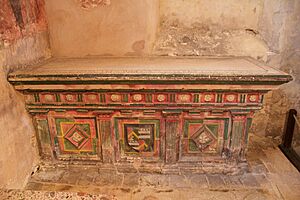Walter Hungerford (Knight of Farley) facts for kids
Quick facts for kids Sir Walter Hungerford |
|
|---|---|
| Spouse(s) | Anne Basset Anne Dormer |
| Issue | |
| 2 children by first wife (names unknown) Edmund Hungerford Susan Hungerford Lucy Hungerford Jane Hungerford 3 illegitimate sons 1 illegitimate daughter |
|
| Father | Walter Hungerford, 1st Baron Hungerford of Heytesbury |
| Mother | Susan Danvers |
| Died | December 1596 |
Sir Walter Hungerford (died December 1596) was an important English landowner. People often called him the "Knight of Farley" because he was very good at sports. When he was young, he got back the family lands that his father had lost. He was a favorite of Queen Mary. His first wife, Anne Basset, was a lady-in-waiting to the Queen. Later, in 1568, he had a legal dispute with his second wife, Anne Dormer. He faced legal consequences for not agreeing to the court's decision regarding his wife.
Contents
Life of Sir Walter Hungerford
Walter Hungerford was the only son of Walter Hungerford, 1st Baron Hungerford of Heytesbury. His mother was Susan Danvers. Her father was Sir John Danvers of Dauntsey, Wiltshire.
Becoming a Landowner
Walter Hungerford took over from his father on July 28, 1540. In 1542, a special law allowed him to regain his family rights. However, he did not immediately get back his father's title or all the lands.
King Edward VI gave him land in 1552. Then, in 1554, Queen Mary gave him the estate of Farleigh Hungerford in Somerset. This happened when the legal punishment against his father was removed. He was made a knight in the same year.
Public Service and Sports
Sir Walter was the Sheriff of Wiltshire several times. He served in 1557, 1572, 1581, and 1587. This role meant he was the chief law enforcement officer in the county.
He was very skilled at outdoor sports. He was even at the first recorded horse race in Wiltshire in 1585.
Later Life and Legal Issues
Sir Walter Hungerford had a legal dispute with his second wife, Anne Dormer. He was unable to prove his claims in court. Because he refused to support his wife or pay the money the court ordered, he spent three years in Fleet Prison.
His wife, Lady Hungerford, later moved abroad. She wrote a letter in 1586. In it, she asked for help to protect her daughters' inheritance from Sir Walter.
In his will, written in 1595, Sir Walter left some property to Margery Bright, with whom he had children. He left the rest of his estate to his half-brother, Sir Edward Hungerford. Sir Walter died in December 1596. After his death, both his wife Anne and Margery Bright sought their legal share of his estate. Lady Hungerford received a good share. She died in 1603.
Portraits of Sir Walter
Two pictures of Sir Walter Hungerford exist as engravings. They are shown in a book called Modern Wiltshire, Heytesbury Hundred. In the earlier portrait from 1560, Sir Walter is in full armor. Around him are items for hunting and hawking. The picture says he was excellent at these activities. The later portrait from 1574 shows him with a hawk on his wrist.
Sir Walter's Family
Sir Walter Hungerford married twice.
First Marriage
His first wife was Anne Bassett. She was a Maid of Honour to Queen Mary. Anne was the daughter of Sir John Bassett of Umberleigh, Devon. Their wedding took place on June 11, 1554. Queen Mary was very happy and wanted everyone to enjoy the celebration. Sir Walter and Anne had two children. Both of them passed away without having their own children.
Second Marriage
By May 5, 1558, he married Anne Dormer. She was the sister of Jane Dormer. Anne was the elder daughter of Sir William Dormer and his first wife, Mary Sidney. Sir Walter and Anne had one son and three daughters:
- Edmund Hungerford: He died in December 1585 without having children.
- Susan Hungerford: She married three times. Her husbands were Michael Ernley, John Moring, and Sir Carew Reynolds.
- Lucy Hungerford: She first married Sir John St. John of Lydiard Tregoze. They had a daughter named Barbara St John. Barbara later married Sir Edward Villiers. Lucy then married Sir Anthony Hungerford of Black Bourton.
- Jane Hungerford: She married Sir John Carne of Ewenny, Glamorganshire.
Sir Walter also had children with Margery Bright. He had two sons and one daughter during his lifetime. Another son was born after his death. Sir Walter married Margery Bright after writing his will. He had heard a rumor that his wife Anne had died.



